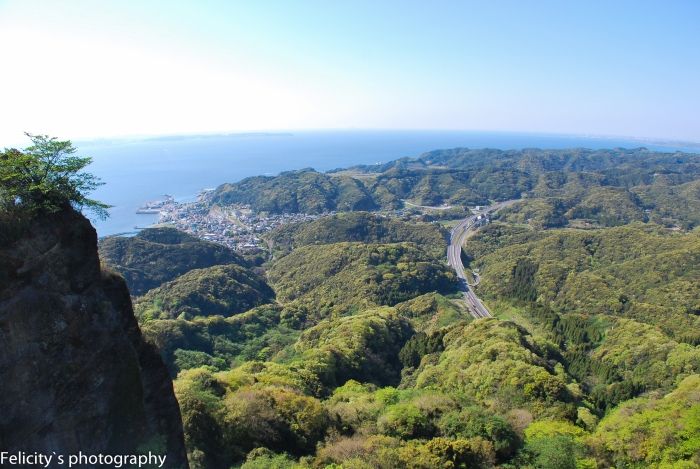Nihon-ji is a complex built on and into the slopes of Mount Nokogiri in Chiba. While most famous for its giant Buddha Daibutsu, it is a worthy hiking destination, with enough stairs to work up a good sweat and a gorgeous view from the top as a reward.

An older couple walking the many-staired trail at Nihon-ji
Built in 725 CE, Nihon-ji has seen periods of neglect and renewal. The Meiji period, when Japan experienced a rapid societal transformation to Western-style industrialism, initially encouraged the destruction of temples, shrines, castles, and anything else considered to be of traditional, non-Western value. Nihon-ji was a victim of this misguided decision, and suffered vandalism of its buildings and Arhat statues.

Arhat statues dot the route – sitting on rock ledges, or in small natural nooks. In the centre of the mostly undamaged, a lone example of the vandalism sits minus its head.
Northern Japan, perhaps due to its proximity to Tokyo and the Meiji reformist government, lost more of its priceless cultural assets than, for example, the Kansai region. Thankfully, the government did put a halt to the destruction, in part due to Minakata Kumagusu, who I will describe in a future blog. Nihon-ji has since become a very popular tourist destination.
The main attraction is undisputedly the Daibutsu, the largest carved from stone in Japan.

Visitors pay their respects at a small shrine at the feet of the Daibutsu
For those who don’t have much time to spend, or aren’t keen walkers, the Daibutsu is a very short distance from the car-park. (map here) As fantastic as a mountain sized Buddha statue is, I really urge you to clear that itinerary, and prep yourself on that Stair-master, because the rest of the hike just gets better.
The Arhat statues were my favourite part of the hike, as each was carved with an individual personality, body-language and facial expressions. Some sit in a calm, meditative poses, while others are visibly angry, or sad, or leaning over to a neighbour make a sly comment about the passing hikers.

In some areas the idiosyncratic Arhat statues give way to whole communities of the more traditional religious avatars – beautiful and dignified.
I took so many photos of the Arhat that, to save on scrolling, I’ve organised them into a small gallery, which you can click on to see bigger images. I hope you enjoy the variety of expressions and my interpretations of them. (Feel like your own interpretation? Make sure to leave a comment!)
After marveling at the giant Daibutsu, and photographing every single Arhat you can find while catching your breath, visitors finally reach the top of the trail. The panoramic ocean meets forested, rolling hills calendar worthy view may knock that breath out of them again, but it’s worth it.

The nearby city of Kyonan, hard up against the sea.

A twist of road is visible from amongst the dense vegetation.

Wow, see how high up the end of the trail is (you get to walk up that)
About 2 hours from Tokyo by train, arriving at Hamakanaya station for the rope-way (there’s a rope-way?) or Hata station to walk up, entry into Nihon-ji is from 8am until 5pm and 600 yen for adults or 400 yen for kids from 4 to 12 years. Their website is Japanese only, but the second last menu at the top アクセス has a basic map for the trains if you want one.
Though I unfortunately won’t be visiting Tokyo or Chiba prefecture any time soon, for those who do find themselves in the vicinity, I really recommend exploring Nihon-ji. I was only exaggerating about the amount of stairs… really!
Have a hike in Japan to recommend? A rival for bigger, better Daibutsu? Just want to say hi? Leave a note in the comments!

Just to give some scale: a lone photographer is dwarfed by the Daibutsu









I’ve been meaning to go to Nokogiriyama for quite some time. Almost did a couple years ago during Golden Week, but thanks to a 35 km hike earlier in the week, my legs weren’t up for it. It’s not so far from me. I just need to go to Yokosuka and take the ferry across to Futtsu.
LikeLike
Thanks for the comment and the info about the ferry! I hope you enjoy it when you go ^^
LikeLike
No problem. Instead of taking the train, the ferry is probably the fastest option. Also interesting, because you get to be on a boat. The ferry runs between Kurihama and Futtsu. I’ve heard it’s only a 30 minute crossing.
LikeLike
Have you seen Mizoguchi’s ‘Life of O-Haru’? There is a scene in that where two of the characters are in a temple, surrounded by statues. The statues are of pilgrims (if I remember rightly) and each one is individual. It gives a certain human warmth to the sculptures, don’t you think – and makes it easy for us to identify with the statues, despite long passages of time? My brother trained as a stonemason, and worked on Canterbury and Chichester cathedrals (in England), and the tradition was that the masons would make portraits of their contemporaries to put on corbels or gargoyles…
LikeLike
No, I haven’t read it, but I will check it out. The statues reminded me of a more benign version of the statue garden in C.S Lewis’ `Lion, Witch and the Wardrobe.’
That’s really interesting about your brother, and what a way to achieve immortality in stone 😛
Thanks for your comment!
LikeLike
Your travels are fantastci
LikeLike
Thank you! Japan is a great place to travel in ^^
LikeLike